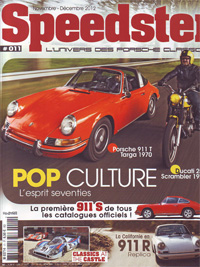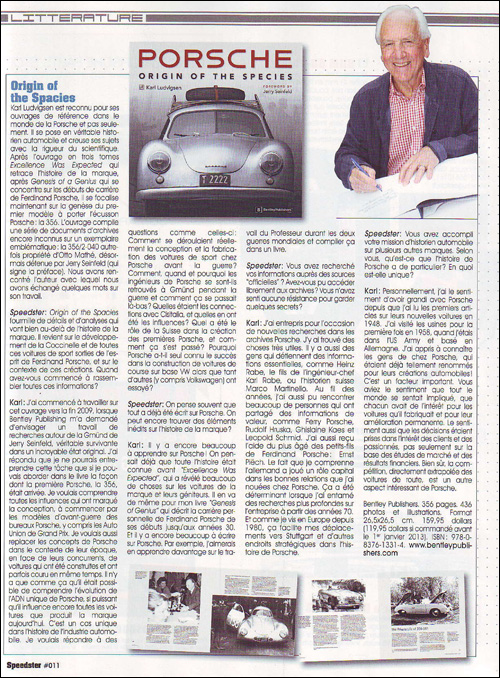|
Porsche - Origin of the Species
Price: $189.95
|

Speedster - Novembre - Décembre 2012
Origin of the Species (translated from the original French)
Karl Ludvigsen is famous not only for his reference works in the world of the Porsche. It comes from being a true automotive historian who researches his subjects with scientific rigor. After his three volume work Excellence Was Expected which retraced the history of the marque, after Genesis of Genius which concentrated on the debut of the career of Ferdinand Porsche, he now focuses on the genesis of the first model to carry to Porsche coat of arms: the 356. The work compiles a series of previously unseen archival documents on an exemplary example: the 356/040 once owned by Otto Mathé, now owned by Jerry Seinfeld (who wrote the preface). We found ourselves with the author with whom we exchanged a few words on his work.
Speedster: Origin of the Species is full of details that cover more than just the history of the marque. It comes back to the developments of the Beetle and all the sports cars originating from the spirit of Ferdinand Porsche, and the context of these creations. When did you start researching information and writing this reference book?
Karl: I started work on this particular book toward the end of 2009 when I was asked by Bentley Publishers to create a work that would feature the wonderfully original Gmünd survivor of Jerry Seinfeld. I said that I would undertake this task if I could address in the book the way in which the first Porsche, the 356, came about. I wanted to understand fully all the many influences that affected the design, starting with the pre-war designs of the Porsche office - even the sports-car versions of the Auto Union Grand Prix car. Also I wanted to place the Porsche designs in the context of their contemporaries and competitors, the cars that were being built and sometimes raced at the same time. Only in this way was it possible to understand the evolution of the unique Porsche DNA, which is so powerful that it still influences all the cars that the company produces today. This is unique in the history of the auto industry.
I wanted to answer such questions as these which are in the minds of Porsche enthusiasts: What really took place before the war in the designing and building of sports cars by Porsche? How, when and why did the Porsche designers find themselves in Gmünd during the war and what was it like there? What were the actual connections with Cisitalia and what was their influence? What was the role of the Swiss in the creation of the first Porsches and how did that come about? Why was only Porsche successful after the war in building a VW-based car when so many others - including Volkswagen - tried to do the same?
Speedster: We currently believe that all has been written about Porsche. Are there details that can still be found about the Porsche story? Did you search the information from the 'official' source at Porsche? Could you freely access the archives, or did you feel some resistance to access some secrets?
Karl: Sorry but there is still very much more to learn about Porsche! People even thought the whole story was known before I wrote Excellence Was Expected, which of course revealed very much more about the Porsche cars and their creators. The same is true of my book Genesis of Genius which describes Porsche's personal career from the beginning to the 1930s.
I did conduct new research at the Porsche archives where I found them very helpful. People who had key information to impart were Hans Rabe, son of designer Karl Rabe, and Marco Martinello, the Swiss researcher of the events in that country. Over the years of course I met many people who had information of value, such as Ferry Porsche, Rudolf Hruska, Ghislaine Kaes and Leopold Schmid. I also had help from Prof. Porsche's oldest grandchild, Ernst Piech. I have mentioned them all in my introduction to the book.
And there is more to write about Porsche! For example I plan to learn more about the work of the Professor in his two World Wars and put this in book form.
Speedster: You worked as an automotive historian on many other car brands. In your view, what is different, particular or exceptional in the Porsche history? Is which way is Porsche unique?
Karl: For me personally I have the feeling that I 'grew up' with Porsche, ever since I saw the first articles about their new cars published in 1948. My first visit to the works was in 1958 when I was in the US Army in Germany. I got to know the Porsche people, who have such a high profile in the creation of their cars. This is an important factor. You had the feeling that everyone was involved, that each had a personal interest in the cars and their constant improvement, that decisions were made in the interest of the customer and the enthusiast and not always on the basis of 'market research' or the financial result. Of course the racing effort, deriving so directly from the road cars, is another appealing aspect of Porsche. The fact that I understand German was of course also helpful in forging good links with Porsche in those days that paid off when I began more serious research into the company starting in the 1970s. Having lived in Europe since 1980 has greatly eased my travels to Stuttgart and other places of importance to the Porsche story.

Article from and courtesy of Speedster
![[B] Bentley Publishers](http://assets1.bentleypublishers.com/images/bentley-logos/bp-banner-234x60-bookblue.jpg)

